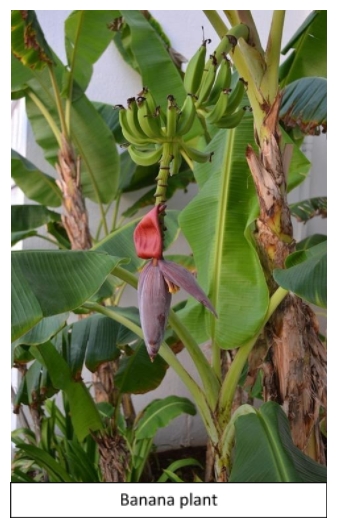Answer
424.8k+ views
Hint: Plants can produce their own food by photosynthesis. The product glucose forms a polymer called starch which can be stored in stems, roots, leaves, fruits, and seeds of a plant.
Complete answer: Solar energy is “fixed” by the green plants by the photosynthetic process. Upon receiving the photon, photosynthesis starts. By this carbon dioxide and water react to form glucose and oxygen. This is how plants and some other photosynthetic organisms produce their own food.
Plants store their food in the form of starch in various parts of them. Starch is a polysaccharide of glucose monomers. Glucose residues are linked by glycosidic bonds. This starch can be stored in the leaves, stems, roots, flowers, fruits, and seeds of a plant. The plants which store food in their stem are cactus, bamboo, pineapple, potato, ginger, onion, banana, etc.
So, the correct option is B. Banana

Note: The underground modification of stem is called rhizome. It is a fleshy and horizontal stem found below the surface of the soil. In these, some small nodes and internodes are found. The nodes/internodes are covered by scaly leaves.
Complete answer: Solar energy is “fixed” by the green plants by the photosynthetic process. Upon receiving the photon, photosynthesis starts. By this carbon dioxide and water react to form glucose and oxygen. This is how plants and some other photosynthetic organisms produce their own food.
Plants store their food in the form of starch in various parts of them. Starch is a polysaccharide of glucose monomers. Glucose residues are linked by glycosidic bonds. This starch can be stored in the leaves, stems, roots, flowers, fruits, and seeds of a plant. The plants which store food in their stem are cactus, bamboo, pineapple, potato, ginger, onion, banana, etc.
So, the correct option is B. Banana

Note: The underground modification of stem is called rhizome. It is a fleshy and horizontal stem found below the surface of the soil. In these, some small nodes and internodes are found. The nodes/internodes are covered by scaly leaves.
Recently Updated Pages
How many sigma and pi bonds are present in HCequiv class 11 chemistry CBSE

Why Are Noble Gases NonReactive class 11 chemistry CBSE

Let X and Y be the sets of all positive divisors of class 11 maths CBSE

Let x and y be 2 real numbers which satisfy the equations class 11 maths CBSE

Let x 4log 2sqrt 9k 1 + 7 and y dfrac132log 2sqrt5 class 11 maths CBSE

Let x22ax+b20 and x22bx+a20 be two equations Then the class 11 maths CBSE

Trending doubts
Fill the blanks with the suitable prepositions 1 The class 9 english CBSE

At which age domestication of animals started A Neolithic class 11 social science CBSE

Which are the Top 10 Largest Countries of the World?

Give 10 examples for herbs , shrubs , climbers , creepers

Difference between Prokaryotic cell and Eukaryotic class 11 biology CBSE

Difference Between Plant Cell and Animal Cell

Write a letter to the principal requesting him to grant class 10 english CBSE

Change the following sentences into negative and interrogative class 10 english CBSE

Fill in the blanks A 1 lakh ten thousand B 1 million class 9 maths CBSE



